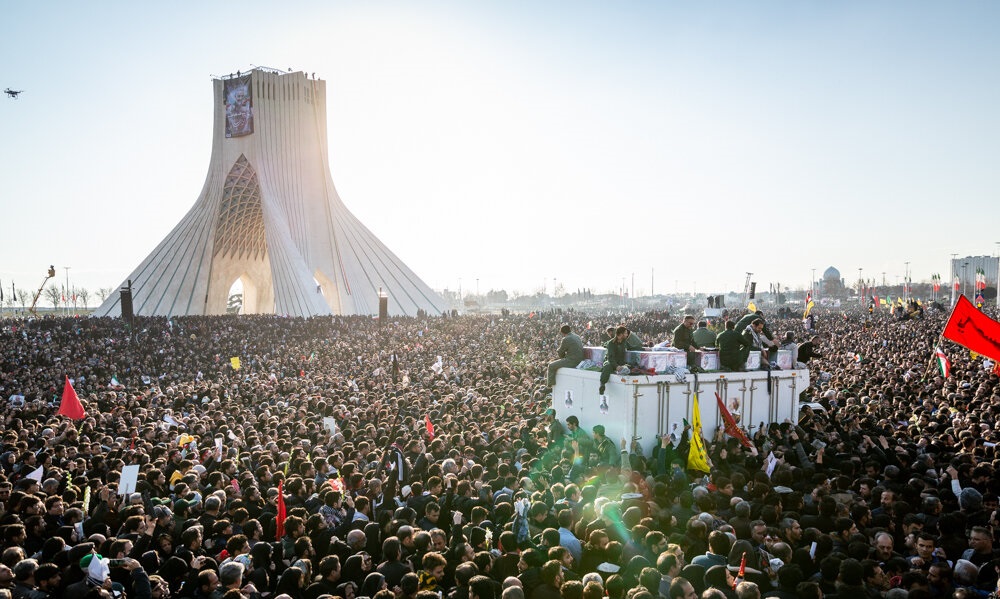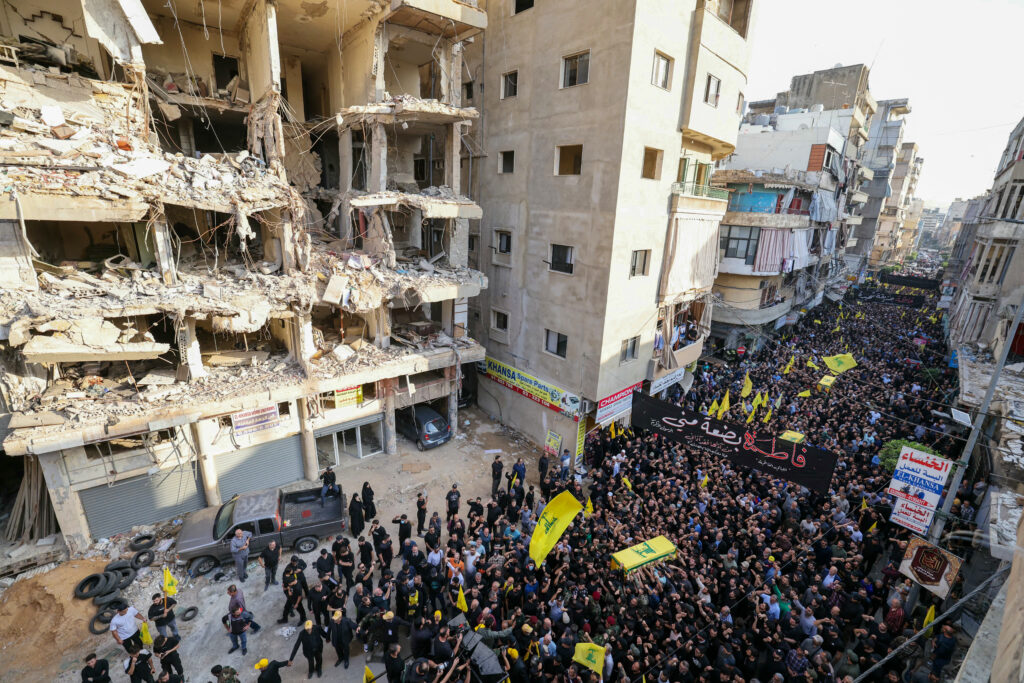Iran’s Blood Revenge
- -

Kevjn Lim writes that “Iran will require American blood” in response to the U.S.’ assassination of top Iranian commander Qasem Soleimani, but the exact extent of the resultant conflict depends on Trump’s response to Iran’s retaliation.
The Middle East unmistakably crossed a new inflection point last Friday, after a US drone strike at Baghdad Airport killed the near-mythical commander of the Iranian Revolutionary Guards’ Qods Force Qassem Soleimani, along with several others.[1] Secretary of State Mike Pompeo asserted that the strike was to thwart an imminent attack, although he then stressed the US’ commitment to de-escalation.[2] President Donald Trump claimed the strike was to stop, not start a war.[3]
Yet this is the first assassination of its kind by the US targeting the Islamic Republic’s very highest state echelons. In one stroke, the US both violated Iraq’s sovereignty and liquidated a figure widely considered Iran’s second most powerful, and whose liege, Supreme Leader Ali Khamenei, had exceptionally called a “living martyr”. Having tremendously expanded Iran’s regional presence and, crucially, repelled the threat posed by the Islamic State, he was not only the face of Iranian power, influence and security but also the foremost symbol of its national pride and honor. This hit job, then, can only be read as a declaration of war for a state which often considers pride and honor even above physical security.
Khamenei vowed “harsh revenge” and swiftly replaced Soleimani with his longtime deputy, the bookish-looking, Mashhad-born Esma’il Qaani.[4][5] While Qaani may have outsized shoes to fill, Soleimani was only the charismatic face of a far larger military organizational machinery at work, one oiled and powered not by any single personality but rather by an undying ideology and the unique political system it undergirds. Iran’s profound loss, then, is more emotive than strategic.
Against the backdrop of spiraling Gulf tensions since the US withdrew from the 2015 nuclear agreement and reinstated Iran oil sanctions, this latest round began when rocket attacks killed an American contractor and wounded several US and Iraqi servicemen at an Iraqi military base in Kirkuk on 27 December.[6] The US retaliated two days later with strikes along the Iraqi-Syrian border, killing half a dozen members of Kata’eb Hezbollah, a component of the Popular Mobilization Forces officially subordinated to the Iraqi Government.[7] On 31 December, pro-Iranian Iraqi militiamen besieged and damaged the US embassy in Baghdad’s highly fortified Green Zone, though without causing casualties.[8] Soleimani’s assassination followed.
Ironically, Soleimani had in October reportedly instructed Kata’eb Hezbollah and other Iraqi militias to intensify attacks on US forces with the aim of provoking US retaliation and diverting the ire of Iraq’s anti-government protesters against the US.[9] On Washington’s part, Trump’s stated intent to retrench American military commitments in the Middle East, and his failure to respond militarily to the attacks against six oil tankers in the Persian Gulf, the US Global Hawk drone, and two Saudi Aramco facilities, have given irresistible incentive for Iran to push its limits in countering unilateral US sanctions pressure. Soleimani’s assassination may therefore have been Trump’s belated attempt to reestablish deterrence. But in so doing he has also started the very war he had claimed to stop.
Iran will retaliate. Its regional allies and clients, including Kata’eb Hezbollah whose leader Abu Mahdi al-Muhandis died beside Soleimani, are expected to intensify attacks against US bases in Iraq and elsewhere. Iran has indicated it will bide its time and strike at a moment and place or places of its choosing.[10] In his first statement as Qods Force Chief, Qaani chillingly vowed that “with patience, the bodies of dead Americans will be seen around the Middle East”.[11] But Hossein Dehqan, military advisor to the Supreme Leader, has also specified, unusually, that Iran’s response would be military and against US military sites.[12] Lebanese Hezbollah Chief Hassan Nasrallah similarly promised that the US military in the region, but not US civilians, would “pay the price”.[13] Hitherto pressured by the thousands of US servicemen around the Persian Gulf, the Middle East and Afghanistan, Tehran is instead now spoilt for choice.
Iran may also attempt to strike US naval forces around the Persian Gulf, perhaps even an aircraft carrier, the ultimate hard symbol of American power and pride. A compound retaliation incorporating for instance cyberattacks could also be in the offing. Ultimately, the specific target list would likely depend on what’s easier to reach, which could still include civilian casualties. Furthermore, Iranian attacks against American servicemen based in the region are likely to force their host countries, particularly in the southern Gulf monarchies, to pick a side and drag them into the fray. Amid all this, Iran has just announced it is no longer bound by the limitations imposed by the nuclear agreement especially on enrichment, even though it left the possibility of a reset if US sanctions were lifted.[14]
So why Iran’s emphasis on a military response at this early stage? There’re three possible reasons. Firstly, Soleimani was a soldier and for many in Iran, the quintessential national hero. A military response would presumably reinstate Iranian honor and pride, not a backhanded terrorist attack against unarmed civilians. Secondly, while the US under Trump continues to defy international norms and expectations, Iran, ironically, has tended towards the opposite, at least in rhetoric. A military response would be proportional in keeping with the Law of Armed Conflict, and avoid international blowback including from Iran’s increasingly important allies China and Russia, with whom Iran has just conducted unprecedented trilateral naval maneuvers.[15] While the US military may be a symmetrical target, Iran’s means about it, including through proxy militias, do not have to be symmetric. But third and perhaps most importantly, attacks against the US military would now aim to help Soleimani achieve in death what he could not in life: the removal of US forces from Iraq and the broader region. Indeed, Iraq’s parliament has just angrily voted to end the presence of international (US) troops in the country.[16]
Iranian leaders have repeatedly dismissed the option of initiating a war.[17] Dehqan has also authoritatively if tantalizingly indicated that if the Americans accept a “blow that is equal to the blow they have inflicted” and refrain from escalating afterwards, they could end the war they started.[18] At the extreme, Iran could still bait the US into starting one, on Iranian soil, at which point the country of over 80 million assumes the defensive where it has comparably greater operational-tactical advantage, and for which it would appear to occupy the higher moral and legal ground.
The gravity of Iran’s response now depends on the potential consequences Tehran is prepared to assume. Trump has defied predictability by proving his willingness to draw blood. He has also threatened to respond by striking 52 Iranian sites, including some of cultural significance, which could violate international law.[19] At the same time, Iran faces a colossal economic crisis at home deepened by sanctions, unprecedentedly violent and widespread anti-government protests in recent weeks, and large-scale demonstrations against its influence in Iraq and Lebanon, which along with Syria have been the Qods Force’s foremost stomping grounds.
Whether they want it or not, both sides are already embroiled in the beginnings of a hot war in a third country. None of this means diplomacy is dead, only that Soleimani’s unavenged assassination makes it momentarily inconceivable. Iran will require American blood. The bigger question is not just how Tehran will respond, but rather what Trump does next.
[1] “Iran’s Qassem Soleimani killed in US air raid at Baghdad airport,” Al Jazeera, 3 January, 2020, https://www.aljazeera.com/news/2020/01/iraq-3-katyusha-rockets-fired-baghdad-airport-200102232817666.html
[2] Ahmed Rasheed, Ahmed Aboulenein, and Idrees Ali, “U.S. says ‘terminated’ top Iran general to thwart attack on Americans,” Reuters, 3 January, 2020, https://www.reuters.com/article/us-iraq-security-blast/u-s-says-it-disrupted-imminent-attack-with-killing-of-iran-commander-idUSKBN1Z11K8
[3] Kevin Liptak and Kaitlan Collins, “How Trump’s decision unfolded to kill a top Iranian general,” CNN, 4 January, 2020, https://edition.cnn.com/2020/01/03/politics/donald-trump-qasem-soleimani-tick-tock-timeline/index.html
[5] https://www.irna.ir/news/83618727/%D8%B1%D9%87%D8%A8%D8%B1-%D8%A7%D9%86%D9%82%D9%84%D8%A7%D8%A8-%D8%B3%D8%B1%D8%AF%D8%A7%D8%B1-%D9%82%D8%A7%D8%A2%D9%86%DB%8C-%D8%B1%D8%A7-%D8%A8%D9%87-%D9%81%D8%B1%D9%85%D8%A7%D9%86%D8%AF%D9%87%DB%8C-%D9%86%DB%8C%D8%B1%D9%88%DB%8C-%D9%82%D8%AF%D8%B3-%D8%B3%D9%BE%D8%A7%D9%87-%D9%85%D9%86%D8%B5%D9%88%D8%A8
[6] John Harney, “U.S. Contractor Killed, Military Personnel Injured in Rocket Attack on Iraqi Military Base,” Time, 28 December, 2019, https://time.com/5756170/us-contractor-killed-iraq/
[7] “Pompeo hits out at Iran after deadly US strikes in Iraq and Syria,” The Guardian, 30 December, 2019, https://www.theguardian.com/us-news/2019/dec/29/us-military-carries-out-defensive-strikes-in-iraq-and-syria
[8] Ghassan Adnan and Isabel Coles, “Militia Supporters Retreat From U.S. Embassy Site in Iraq,” The Wall Street Journal, 1 January, 2020, https://www.wsj.com/articles/protesters-retreat-from-u-s-embassy-site-in-iraq-11577891592
[9] “Inside the plot by Iran’s Soleimani to attack U.S. forces in Iraq,” Reuters, 4 January, 2020, https://www.reuters.com/article/us-iraq-security-soleimani-insight/inside-the-plot-by-irans-soleimani-to-attack-u-s-forces-in-iraq-idUSKBN1Z301Z
[10] https://www.tasnimnews.com/fa/news/1398/10/14/2174246/%D8%B3%D8%B1%D8%AF%D8%A7%D8%B1-%D8%B4%DA%A9%D8%A7%D8%B1%DA%86%DB%8C-%D8%A7%DB%8C%D8%B1%D8%A7%D9%86-%D8%AF%D8%B1-%D9%BE%D8%A7%D8%B3%D8%AE-%D8%AF%D9%87%DB%8C-%D8%B9%D8%AC%D9%84%D9%87-%D9%86%D9%85%DB%8C-%DA%A9%D9%86%D8%AF-%D8%B2%D9%85%D8%A7%D9%86-%D9%85%DA%A9%D8%A7%D9%86-%D9%88-%DA%86%DA%AF%D9%88%D9%86%DA%AF%DB%8C-%D8%B9%D9%85%D9%84%DB%8C%D8%A7%D8%AA-%D8%B1%D8%A7-%D9%85%D8%A7-%D8%AA%D8%B9%DB%8C%DB%8C%D9%86-%D9%85%DB%8C-%DA%A9%D9%86%DB%8C%D9%85
[11] https://www.khabarfoori.com/detail/1628070/%D8%B3%D8%B1%D8%AF%D8%A7%D8%B1-%D9%82%D8%A7%D8%A2%D9%86%DB%8C:-%DA%A9%D9%85%DB%8C-%D8%B5%D8%A8%D8%B1-%DA%A9%D9%86%DB%8C%D8%AF-%D9%88-%D8%A8%D8%A7-%DA%86%D8%B4%D9%85%D8%A7%D9%86-%D8%AE%D9%88%D8%AF-%D8%A8%D9%82%D8%A7%DB%8C%D8%A7%DB%8C-%D8%A7%D8%AC%D8%B3%D8%A7%D8%AF-%D8%B4%DB%8C%D8%B7%D8%A7%D9%86-%D8%A8%D8%B2%D8%B1%DA%AF-%D8%B1%D8%A7-%D8%AF%D8%B1-%D8%AE%D8%A7%D9%88%D8%B1%D9%85%DB%8C%D8%A7%D9%86%D9%87-%D8%AE%D9%88%D8%A7%D9%87%DB%8C%D8%AF-%D8%AF%DB%8C%D8%AF
[12] Fred Pleitgen, Tim Lister, and Schams Elwazer, “Exclusive: Iran’s response to US will be military — Khamenei’s adviser,” CNN, 5 January, 2020, https://edition.cnn.com/2020/01/05/middleeast/iran-soleimani-khamenei-adviser-intl/index.html
[13] “Nasrallah Threatens U.S.: American Military Bases, Warships Are ‘Fair Targets’,” Haaretz, 5 January, 2020, https://www.haaretz.com/middle-east-news/nasrallah-says-soleimani-killing-marks-start-of-new-phase-for-the-region-1.8354952
[14] https://www.irna.ir/news/83622446/%DA%AF%D8%A7%D9%85-%D9%86%D9%87%D8%A7%DB%8C%DB%8C-%D8%AA%D9%88%D9%82%D9%81-%D8%A2%D8%AE%D8%B1%DB%8C%D9%86-%D9%85%D8%AD%D8%AF%D9%88%D8%AF%DB%8C%D8%AA-%D9%87%D8%A7%DB%8C-%D8%B9%D9%85%D9%84%DB%8C%D8%A7%D8%AA%DB%8C-%D8%A7%DB%8C%D8%B1%D8%A7%D9%86-%D8%AF%D8%B1-%D8%A8%D8%B1%D8%AC%D8%A7%D9%85
[15] “Russia, China, Iran start joint naval drills in Indian Ocean,” Reuters, 27 December, 2020, https://www.reuters.com/article/us-iran-military-russia-china/russia-china-iran-start-joint-naval-drills-in-indian-ocean-idUSKBN1YV0IB
[16] Isabel Coles and Catherine Lucey, “Trump Pushes Iraq, Threatens Sanctions After Vote to Expel U.S. Troops,” The Wall Street Journal, 6 January 2020, https://www.wsj.com/articles/iraqi-parliament-votes-in-favor-of-expelling-u-s-troops-11578236473
[17] https://www.tasnimnews.com/fa/news/1398/10/14/2174274/%DA%AF%D9%81%D8%AA-%D9%88%DA%AF%D9%88-%D8%B0%D9%88%D8%A7%D9%84%D9%86%D9%88%D8%B1-%D9%BE%D8%A7%D8%B3%D8%AE-%DA%A9%D9%88%D8%A8%D9%86%D8%AF%D9%87-%D8%A8%D9%87-%D8%AC%D9%86%D8%A7%DB%8C%D8%AA-%D8%A2%D9%85%D8%B1%DB%8C%DA%A9%D8%A7%DB%8C%DB%8C-%D9%87%D8%A7-%D9%85%DB%8C-%D8%AF%D9%87%DB%8C%D9%85-%D8%A7%DB%8C%D8%B1%D8%A7%D9%86-%D9%87%DB%8C%DA%86-%D9%88%D9%82%D8%AA-%D8%A2%D8%BA%D8%A7%D8%B2%DA%AF%D8%B1-%D8%AC%D9%86%DA%AF-%D9%86%DB%8C%D8%B3%D8%AA
[18] Fred Pleitgen, Tim Lister, and Schams Elwazer, “Exclusive: Iran’s response to US will be military — Khamenei’s adviser,” CNN, 5 January, 2020, https://edition.cnn.com/2020/01/05/middleeast/iran-soleimani-khamenei-adviser-intl/index.html
[19] Ahmed Aboulenein, Maha El Dahan, and David Shepardson, “Trump vows to hit 52 Iranian targets if Iran retaliates after drone strike,” Reuters, 5 January, 2020, https://www.reuters.com/article/us-iraq-security/trump-vows-to-hit-52-iranian-targets-if-iran-retaliates-after-drone-strike-idUSKBN1Z4003
Image Caption: Funeral of Qasem Soleimani, Tehran, Iran. Photo: Mehr News Agency, shared on Wikipedia Commons.







